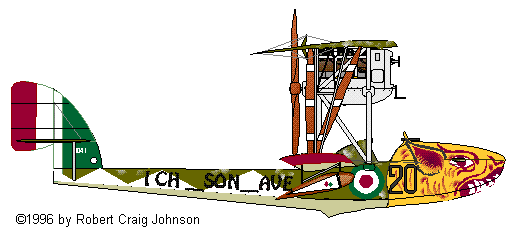
injection-molded and cast-metal parts,
decals. UK £10.99.
Italy and Austria-Hungary fought World War I across the waters of the Adriatic. Both made substantial use of pusher-engined flying boats which owed more or less to the example set by the Austro-Hungarian Lohner firm's L-type 2-seater. After capturing one of these aircraft and noting its excellent qualities, the Italians commissioned copies (M types) from Macchi, then the Italian Licensee for Nieuport aircraft. The subject of the latest offering from Pegasus, the Macchi M.5 single-seat seaplane, combined the best of the firm's Nieuport experience with finest features of the Lohner marine aircraft. It was arguably the best marine fighter of the war.

The Pegasus M.5 is one of the manufacturer's typically well turned-out model kits. The plastic pieces are finely molded in the firm's characteristic, soft, gray plastic. The upper wing is split into two panels and has very fine trailing edges. The engine nacelle is nicely done. You build up the Isotta-Fraschini engine from several plastic and cast metal parts. Unfortunately, these do not include the crankcase, so you will have to make at least its upper half from scrap plastic. Detail on the radiator is soft and indistinct. The white metal struts, engine details, cockpit pieces seat and control stick), propeller, and beaching dolly are beautifully cast, with only minor flash on the dolly wheels.
The fuselage is engineered rather oddly. There are two longitudinal halves, with additional panels on both the upper deck and the underside. One benefit of this arrangement is that, by leaving the underside panel off, you can mount the cockpit interior after mating the fuselage halves. The reasons for the upper deck panel are harder to discern. Available photographs make it hard to tell whether there was a similar panel on the original machines.
Scale accuracy is likewise difficult to assess because references are hard to find. This reviewer relied on two very old volumes, Fighter Aircraft of the 1914-1918 War and Marine Aircraft of the 1914-1918 War, both published by Harleyford over 30 years ago. Unfortunately, the material that came with the kit was of little help. Like other recent WW1 offerings from this maker, the kit features annoyingly skimpy instructions and no three-view drawings.
The small decal sheet is well printed but very basic. It includes roundels, printed with separate centers, and fin flashes. But there is only a single, generic serial number.
This is a nice kit of a little-known subject that has never before appeared as a 1/72-scale kit. Builders may be hampered by a lack of reference materials, particularly when it comes to final assembly of the wing and strut structures.
Highly recommended.